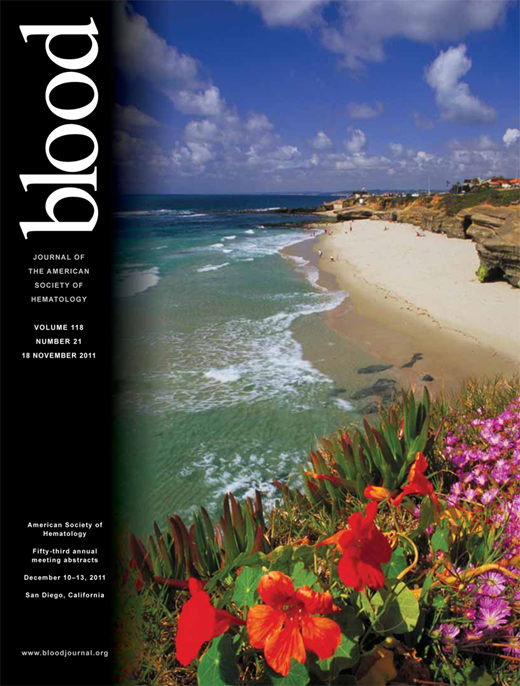Abstract
Abstract 3597
The incidence of acute promyelocytic leukemia (APL) shows racial variations. Population based epidemiologic studies are feasible because of common diagnostic criteria and treatment. The prognosis of APL has substantially improved since the advent of all trans-retinoic acid (ATRA) and arsenic trioxide (As2O3).
Data on survival and relapse of consecutive APL patients in Hong Kong from 1991 to 2011 were obtained from the Hong Kong Cancer Registry (with at least 98% reporting and complete follow-up), and verified by hospital records. Data were censored at the end of July 2011. Potential factors impacting on survival including age, platelet count (Plat), white blood cell count (WBC), gender; 5-year cohort and As2O3 maintenance were analyzed by logistic regression.
Four hundred and eight cases of APL (198 men, 210 women) at a median age of 41 (3–89) years were registered. There was a rise in cases number with successive 5-year cohorts, but the WHO standardized age incidence rate (WSIR) was unchanged (Table 1). At diagnosis (Dx), the median hemoglobin was 8.4 (2.9–14.9) g/dL, WBC 17.7 (0.3–250) × 109/L (>10 × 109/L in 129 cases) and Plat 35 (3–270) × 109/L (< 40 × 109/L in 282 cases). Early death (within 30 days of Dx) occurred in 88 cases. Complete remission (CR) was achieved in 318 cases. Outcome was unknown in 2 cases. The incidence of early death decreased progressively with each 5-year cohort (p=0.035), but was positively correlated with older age (p<0.001), high WBC (p<0.001) and male gender (trend only, p=0.06). From CR1, the median follow-up was 83 (0–249) months. Relapse occurred in 108 cases. The 5-year relapse rate fell from 54% (no maintenance) to 16% (p<0.001) with the adoption of ATRA (n=110) and oral As2O3 (n=88; since 2001) maintenance. Relapse rates were lower in patients receiving As2O3 than ATRA maintenance (17% versus 38%; p=0.008). Risk factors predicting relapse were older age (p=0.001), no oral-As2O3 maintenance (p=0.003), high WBC (p=0.023) and male gender (trend only, p=0.056). For relapsed patients, 5-year overall survival (OS) from CR1 was improved from 67% with ATRA (1993–1998) to 96% with oral-As2O3 (since 1999–2011) treatment. The causes of deaths after CR1 were APL relapse (n=35), second cancer (n=8), bone marrow transplantation (BMT, n=7), chemotherapy (n=3) and unrelated causes (n=6). Allogeneic BMT was not performed since 1999. For the last 5-year cohort (2006–2011), there were no APL related deaths after CR1. With reduction of induction death, and improvement in treatment and prevention of relapses, the 5-year OS from diagnosis increased from 44% for the first 5-year cohort to 80% for the last 5-year cohort. On multivariate analysis, age (p<0.001) and cohort period (p=0.031) were determinants of OS.
| Time cohort . | 1991–1995 . | 1996–2000 . | 2001–2005 . | 2006–2011 . | p value . |
|---|---|---|---|---|---|
| Number of cases | 74 | 90 | 108 | 136 | — |
| WSIR per 100000 / year | 0.23 | 0.25 | 0.29 | 0.29 | NS |
| Number of early death (%) | 20 (27%) | 20 (22%) | 25 (23%) | 23 (17%) | 0.035 |
| 5-year DFS from Dx | 50% | 50% | 71% | 71% | <0.001 |
| 5-year OS from Dx | 44% | 64% | 64% | 80% | 0.004 |
| 5-year DFS from CR1 | 46% | 43% | 68% | 84% | <0.001 |
| 5-year OS from CR1 | 67% | 82% | 82% | 96% | 0.006 |
| Time cohort . | 1991–1995 . | 1996–2000 . | 2001–2005 . | 2006–2011 . | p value . |
|---|---|---|---|---|---|
| Number of cases | 74 | 90 | 108 | 136 | — |
| WSIR per 100000 / year | 0.23 | 0.25 | 0.29 | 0.29 | NS |
| Number of early death (%) | 20 (27%) | 20 (22%) | 25 (23%) | 23 (17%) | 0.035 |
| 5-year DFS from Dx | 50% | 50% | 71% | 71% | <0.001 |
| 5-year OS from Dx | 44% | 64% | 64% | 80% | 0.004 |
| 5-year DFS from CR1 | 46% | 43% | 68% | 84% | <0.001 |
| 5-year OS from CR1 | 67% | 82% | 82% | 96% | 0.006 |
Population based incidence data showed that APL in Hong Kong was more prevalent than the United States (0.15–0.18/100000/year). Oral-As2O3 has markedly changed the outcome of APL patients. Early death is now the greatest problem curtailing survival of APL patients.
No relevant conflicts of interest to declare.
Author notes
Asterisk with author names denotes non-ASH members.

